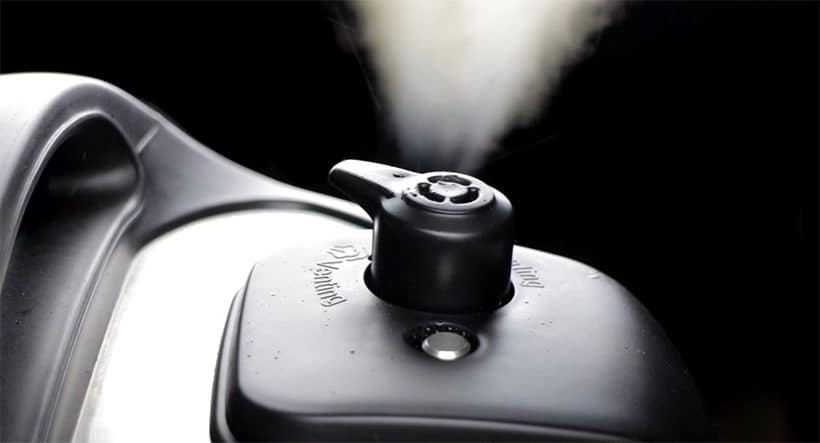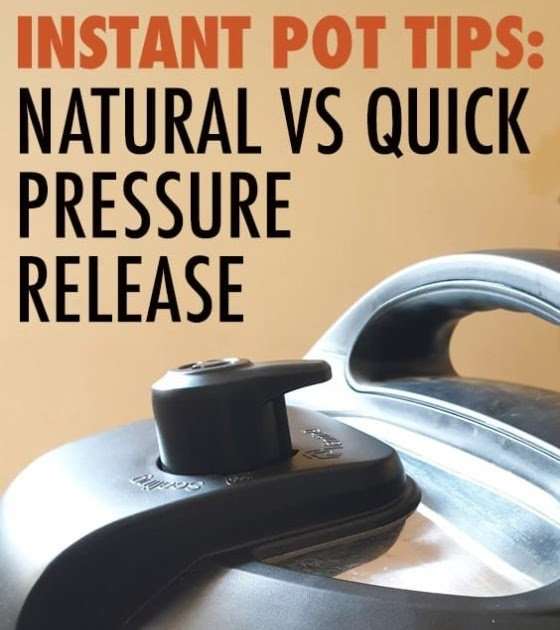Does It Really Matter Which You Use
Yes, it is important to depressurizing your pressure cooker in the right way, according to the food youre cooking. It can make a huge impact on the foods texture and temperature. Just like leaving a steak on the grill too long, your food can become overcooked and dry if you release pressure in the wrong way.
Two of the main concerns are:
- Releasing the pressure too quickly when cooking a pot full of soup or foamy foods. When you do a manual release of a pot full of soup or broth, its possible that the steam will sputter and spray all over your kitchen. It can take quite a while for a pot full of liquid to release pressure, so it can take a good 5 minutes to release it with a manual release. During that time, steam is spraying and heavy aromas are filling your house.
- Overcooking delicate foods. If youre cooking asparagus in the Instant Pot and you allow it to do a natural release of pressure, its likely the asparagus will be complete mush before you take it out. The same applies to any vegetables youre steaming. It also applies to meats that dry out when over cooked, like chicken breast or salmon.
Smart Program Pressure Cooking
If you choose to use one of the pre-set smart program options, the steps are even simpler. Please refer to our post on Smart Program Instant Pot Buttons Explained for how to adjust each setting.
Step 1. Start the Instant Pot. Insert the inner pot into the cooker base.
Step 2. Add ingredients and liquids to the inner pot. Stir if needed or leave layered.
Step 3. Secure and lock the lid. Make sure everything feels well sealed.
Step 4. Select one of the Smart Program buttons. Pre-set cooking time and pressure level will display. You can leave it as is or adjust things like the pressure level from HIGH to LOW. You can press the Smart Program button again to cycle through the Less, Normal and More time options or use the and + buttons to adjust the cooking time further. If you make any adjustments to the selected Smart Program, they will be remembered next time you use it.
Step 5. Preheating & pressurizing stage begins followed by cooking under pressure as per program settings. Once the Instant Pot beeps again and the timer has reached zero, the cooking process is done.
Step 6. You can do a quick release or allow the built-up pressure to release naturally , or do both depending on the food/recipe.
Step 10. Once pressure is released, open the lid and stir or remove the contents.
How To Use Quick Release On An Instant Pot
Ready to try quick release? Follow these steps:
Recommended Reading: How To Cook Whole Chicken In An Instant Pot
Pressure Cooking Requires Liquid
Before we continue, we must mention the most important aspect of pressure cooking. It requires liquid. This is because the pressure is built by the steam accumulating inside the pot, which is produced from the liquid.
Whether youre cooking rice, chicken breasts, pot roast, carrots, stew or cheesecake, you will need at least a cup of liquid for the Instant Pot to do its job.
This is a total amount of liquid and can be in the form of water, stock, tomato sauce, juice, wine and liquids released from the food while cooking , or a combination of those. Amount of liquid required varies depending on the recipe and amount of food but as a rule of thumb, 1 cup is always a good starting point. Also, the food doesnt need to be completely covered or submerged in liquid to cook.
How To Safely Release Pressure From The Valve Of Your Instant Pot

Once you hear your Instant Pot beeping because the food is done, you can choose to release the pressure immediately or let it sit for a bit before releasing .
When you’re ready to release, grab the handle of the pressure release valve and turn it downwards to the Venting position.
Once all of the pressure is released from the valve, the pin should go down , and you can safely open up the Instant Pot.
Bon appétit!
Releasing the pressure when cooking with an Instant Pot can be a bit scary at first, but you get used to it once you start using it more. Just make sure to never touch the handle of the pressure release knob directly, as hot steam and liquid coming out may burn you. Always use something to turn the knob , divert the steam away from cabinets, and also release in controlled bursts for lots of liquid or starch.
You May Like: How Long To Cook Red Potatoes In Instant Pot
What Is Natural Release
Instant Pot natural release is when you allow the Instant Pot to cool down by itself, releasing steam slowly. When the food is done cooking, the Instant Pot will automatically release steam gradually until the float valve drops down. This could take up to 30 minutes.
We recommend natural release for soups and other food with high liquid content.
How Do You Turn Off The Water In A Pressure Cooker
Below are some tips to help you fix your pressure cooker from home: Gasket Leakage. Visually check your gasket. Check for damage to the pot itself. Use a ruler to measure the diameter of the pressure cookers bottom in a few different places. Vent Leakage. Worn O-rings on Valve. Handle Leakage. Rim Leakage.
Read Also: How To Cook Pork Shoulder In Instant Pot
How To Do An Instant Pot Natural Release
Once the cooking is done, wait for the Floating Valve to drop down completely before taking off the lid.
Always rotate the Venting Knob from the Sealing Position to the Venting Position to release all the pressure before opening the lid.
The process of releasing the pressure roughly takes about 10 25 minutes depending on the quantity of food present in the Instant Pot.
What Causes It To Break
Its likely that you might not know that the natural release mechanism of your instant pot is broken until youre already cooking something inside it. In that case, youll have an instant pot thats very high pressure, which can be a dangerous thing indeed.
When cooking with an instant pot, you first add some liquid to the cooking ingredients. This liquid turns to steam, increasing the internal pressure of the instant pot. Natural release just means that you allow the internal pressure of the instant pot to slowly release through the steam vent which is included in the lid of the pot.
Over the course of fifteen minutes, the pressure will equalize, making it safe to open the instant pot.
You May Like: Can You Use An Instant Pot For Canning
Use Quick Release For Foamy Food Or When It Is Overfilled
Have you seen pictures of applesauce splattered all over the Instant Pot through the Venting Knob?
Mistake: Many new users are unsure when to use Quick Pressure Release and Natural Pressure Release. Theres a chance of splattering if users use Quick Release when cooking foamy food, such as grains or beans.
Solution #1: Use Natural Release for foamy food or when the pot is overfilled.
But waitmost pasta recipes call for Quick Release, what should we do?
Solution #2: Release the pressure gradually.
You dont have to turn the Venting Knob all the way to Venting Position to release pressure.
The initial release is usually the strongest. So, release the pressure gradually by turning the venting knob just a little with your hand or wooden spoon until you hear a hissing sound. Hold it at that position to release the pressure gradually.
Whats The Benefit Of Using Natural Release
If youre cooking liquid foods like soups or foamy foods like beans and potatoes, natural pressure release is considered to be great for keeping your kitchen clean and mess-free.
The reason is that the natural and gradual pressure release enables lesser movement inside the pressure cooker. Your soup or stock will come out cleaner and your food is more likely to stay intact with this method.
You May Like: How Long To Cook Beef Tips In Instant Pot
Recommended Foods For Quick Release
You should consider quick release if you want to cook delicate foods like vegetables, poultry, a rice recipe, or pasta. As these foods have a tendency to turn mushy, the quick release method can help to combat that issue.
You can also consider quick release if you want to cook something that requires adding ingredients in the instant pot once your food is partially cooked. Release the pressure quickly by pushing the steam release button, open the lid, add your ingredients, close it, and program the pot to continue pressure cooking.
The quick release is the fastest way of cooking, but it comes with a list of precautions. As the steam is hot above the boiling point, it can burn your skin if you have not taken any safety precautions.
It is best to read the user manual and its care instructions before using an instant pot, especially while releasing the pressure through the quick release method.
What Is Natural Release Time

Natural release time relies on the following two factors:
The Size of Your Instant Pot
The instant pot is available in 4 different sizes: 3-quart, 5-quart, 6-quart, or 8-quart. The larger the size, the longer it will take for pressure to release.
The 8-quart Instant pot has a larger capacity, so it is likely to build up a larger volume of pressure. On the other hand, a 6-quart and a 3-quart instant pot will take less time to do a natural release.
Whats In the Instant Pot
The natural release process may last anywhere between a couple of minutes to 30 minutes, depending on what you are cooking. If cooking takes less time, the instant pot will have less natural release time and vice versa.
Also Check: How To Cook Lentils In The Instant Pot
Is Natural Release Safer Than Quick Release
In short, yes, the natural release is comparatively safer than quick release.
Natural release takes its own time to depressurize the instant pot. There is no risk of you coming into contact with steam as the pot itself removes the steam.
When using the quick release method, you have to take certain precautions like avoiding an instant pot mistake. Its important to avoid direct contact with the steam and ensure that the food is not splattering out from the steam release valve.
If youre using a quick release method, a good rule of thumb is to stay back and avoid leaning your face or placing your hand over the cooker while it is releasing the steam. You may want to use kitchen tongs or a wooden spoon to push the valve, to avoid your skin coming in direct contact with the hot steam.
How To Natural Release Instant Pot
Never force the Instant Pot lid open! If it wont open it is most likely because there is too much pressure remaining in the pot.
Recipes Great for the Natural Release Setting
- Instant Pot Chili perfect weeknight meal
You May Like: How To Use An Instant Pot Duo
Causes Why Food Burn Happens
Read Also: Burn Food Message Instant Pot
Recommended Foods For Natural Release
Using natural release is good for cooking foods that need prolonged cooking.
For example, cooking foods like beans is better with the natural release method. These foods can withstand the extra cook time as the steam releases, and natural release will ensure they do not get ripped apart from the force of escaping steam.
It is also recommended to use this method for liquid foods like soup, or foamy foods like potatoes and oatmeal. As the steam is released gradually, you wont have to worry about the liquid splattering out of the instant pot and creating a mess around the kitchen.
You can also consider natural release while cooking meat, especially recipes like pot roast. The gradual release of the pressure allows the meat to rest, making it tender and juicier.
Also Check: Is Instant Pot Worth It
How To Safely Use The Pressure Valve On Your Instant Pot
So you just got an Instant Pot and can’t wait to use it to cook up some quick and easy delicious meals. There’s one problem: that pressure release valve can be a bit scary at first, and you don’t want to get hit with super hot steam as you try and get to your food! Don’t worry, we’re going to show you how to safely release the pressure from the valve in this guide.
Natural Release Vs Quick Release
Then of course you are probably wondering what the difference is between natural release and quick release.
Natural release is waiting for your food to release its pressure without you having to hit the valve from sealing to venting.
Whilst quick pressure release is moving the valve from sealing to venting as soon as the instant pot beeps.
For more information and to compare I recommend you check out how to quick release instant pot, which is episode 4 of this podcast series.
Recommended Reading: How To Do White Rice In An Instant Pot
Pressure Leakage Due To Loose Sealing Ring
The sealing ring is the last thing that could be wrong with your instant pots pressure system. The steam can sometimes be seen seeping out the sides. If the lid appears to be in good condition, check the sealing ring.
Within the lid, a sealing ring is designed to prevent the Instant Pot from over-pressurizing.
Suppose your sealing ring is not properly seated or has become loose over time and use. In that case, it becomes incapable of forming a proper seal. It means that even though your instant pot was supplying heat to the inner chamber, you were not properly cooking your food.
How Long Does Natural Release Take

Natural Release time depends on:
- The size of your Instant Pot 3 quart, 6 quart or 8 quart.
- Whats inside what you are cooking.
8 quart Instant Pot has larger pot , so larger volume of pressure to build up inside. If it is meal type recipe, barely any liquid in final product like Instant Pot chicken breast or Instant Pot teriyaki chicken, Natural Release takes about 10 minutes. For Instant Pot lentil soup for example, it could take as much as 40 minutes for pressure to release fully because the pot is large, and all that hot liquid keeps the steam going.
6 quart Instant Pot takes less time to do Natural Release anywhere from 5 to 20 minutes. Thats one of the features I like about smaller pressure cooker.
Wondering which size works for you? Check out my post on which Instant Pot to buy?!
You May Like: How To Can In An Instant Pot
